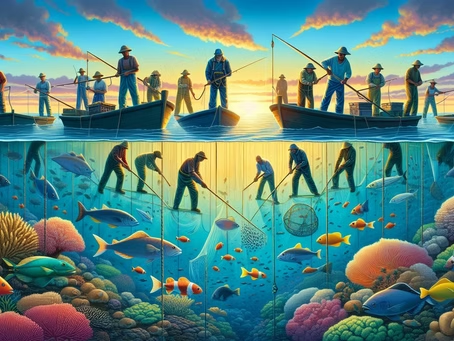Introduction
The ocean’s vast waters are more than a marvel—they are a vital source of food for billions worldwide. Sustainable fishing is at the heart of maintaining marine biodiversity while ensuring that seafood remains available for generations to come. This guide explores why sustainable fishing matters, the techniques and technologies supporting it, the influence of consumers and policymakers, and the challenges shaping the future of global fisheries.
The Big Picture: Why Sustainable Fishing Matters
Understanding the Ocean’s Bounty
The sea is home to a staggering diversity of life, from plankton to whales. Commercially, thousands of species are harvested, feeding communities across the globe. Sustainable fishing ensures that this bounty continues to thrive, balancing human demand with ecological preservation.
The Ripple Effect of Overfishing
- Predator loss can lead to overabundant prey and harmful algal blooms.
- Coral reefs decline without fish that maintain their balance.
- Communities depending on fisheries suffer economically when stocks collapse.
Overfishing is not just an ecological crisis—it is a human one, threatening livelihoods, food security, and biodiversity.
Balancing Our Needs with Ocean Health
Sustainable fishing prevents overexploitation while protecting habitats and species. The goal is simple yet vital: harvest what the ocean can replenish, safeguard ecosystems, and keep seafood accessible for generations.
Tackling the Issue: What is Sustainable Fishing?
Defining Sustainable Seafood
Sustainable seafood comes from fisheries or farms that protect species, ecosystems, and communities. It is not a label of convenience—it is a promise that the fish on our plates today won’t endanger tomorrow’s ocean balance.
The Principles of Responsible Fishing
- Respecting catch limits to maintain healthy populations.
- Using gear that minimizes habitat damage and bycatch.
- Protecting spawning grounds and vulnerable species.
Certifications and Their Value
Eco-labels signal responsible sourcing. They guarantee traceability, reduced environmental impacts, and fair labor practices. Choosing certified seafood is one of the simplest ways consumers can support ocean health.
On the Water: Sustainable Fishing Techniques
Pole-and-Line Fishing
This low-impact method catches fish one at a time, reducing bycatch and preserving habitats. While slower, it emphasizes quality over quantity.
Selective Gear
Innovative nets and hooks allow smaller or non-target species to escape. Escape devices and seasonal closures further protect vulnerable populations.
Aquaculture Done Right
Responsible aquaculture provides seafood without overfishing. It relies on sustainable feed, clean operations, and ecosystem-friendly practices to supply fish while protecting the ocean.
The Role of Technology in Sustainable Fishing
- Electronic Monitoring Systems: Cameras and sensors track catches and enforce quotas.
- Bycatch Innovations: Modified trawls, precision hooks, and deterrent devices reduce harm to non-target species.
- Traceability Apps: QR codes and blockchain provide consumers with transparency from sea to plate.
From Sea to Plate: The Consumer’s Impact
Making Informed Choices
Consumers shape demand. By asking questions, seeking certifications, and consulting seafood guides, buyers can ensure their meals support sustainability.
The Power of the Purse
Every purchase is a vote. Supporting certified fisheries and local sustainable practices pushes the industry toward responsible methods.
Navigating Eco-Labels
Eco-labels and seafood guides simplify decision-making. They provide assurance that seafood meets environmental and social standards.
Global Efforts and Policies
International Cooperation
Agreements such as UNCLOS and regional fisheries management frameworks help regulate shared waters and fish stocks.
Governments and NGOs
Governments set policies and enforce quotas, while NGOs raise awareness, support communities, and advocate for stronger protections.
Success Stories
- Norway: Strict science-based quotas preserve fish stocks.
- New Zealand: A quota system keeps fisheries productive.
- Palau: A vast marine sanctuary protects biodiversity.
Community and Culture
Indigenous Wisdom
Indigenous fishing traditions emphasize seasonal harvests, minimal bycatch, and respect for marine life, offering valuable lessons for modern fisheries.
Community-Managed Marine Areas
Local fishers often design and enforce their own conservation zones, balancing cultural values with ecological needs.
Celebrating Sustainable Traditions
Festivals and heritage recipes showcase sustainable seafood, blending culture, cuisine, and conservation.
Challenges and Controversies
- IUU Fishing: Illegal and unreported fishing undermines sustainability, but satellites, drones, and stricter port measures are helping combat it.
- Marine Protected Areas: Conservationists champion them, while some fishers fear restricted access. Balance is essential.
- Climate Change: Shifting species ranges and disrupted food webs demand adaptive, science-driven management.
Education and Advocacy
School programs, public campaigns, and media storytelling inspire awareness. Advocates can influence change by supporting certified seafood, spreading knowledge, and joining conservation efforts.
Looking Ahead: The Future of Fishing
- Innovations: Biodegradable gear, selective breeding, and advanced surveillance reduce harm and boost efficiency.
- Ecosystem Resilience: Restoring reefs, mangroves, and habitats helps oceans withstand environmental stress.
- Food Security: Sustainable aquaculture and consumer awareness ensure seafood remains accessible to future generations.
Conclusion
Sustainable fishing is a lifeline for oceans and humanity. By balancing ecological preservation with responsible harvesting, embracing new technologies, and supporting community-driven efforts, we can secure a thriving ocean and a sustainable food supply. Every informed choice we make strengthens the tide toward healthier seas.
Frequently Asked Questions
What is sustainable fishing?
A practice that maintains fish populations, ecosystems, and community livelihoods for the long term.
Why does it matter?
It prevents overfishing, preserves biodiversity, and ensures seafood for future generations.
What techniques are used?
Pole-and-line fishing, selective gear, and responsible aquaculture are leading methods.
How can consumers help?
By choosing eco-labeled products, asking questions, and supporting sustainable fisheries.
What are eco-labels?
Labels and guides that confirm seafood is responsibly sourced.
What role do policies play?
Governments and NGOs enforce quotas, create marine reserves, and support conservation.
How is technology applied?
Electronic monitoring, bycatch reduction devices, and traceability apps improve accountability and sustainability.
What challenges remain?
IUU fishing, climate change, and balancing conservation with local needs remain pressing concerns.

